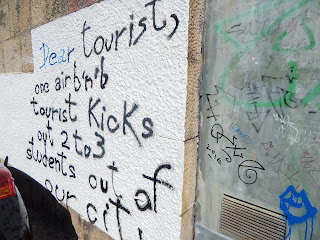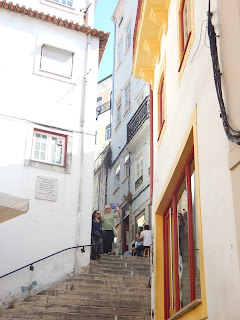
We caught a bus (motor coach) at 8:30AM for the 15 minute ride to the Caldas da Rainha bus station where we purchased a ticket to Coimbra. We had 90 minutes to enjoy a coffee and a croissant filled with pastry cream. The pastries and coffee everywhere are fabulous and cheap!
The bus ride to Coimbra, the quintessential university town, the Oxford of Portugal, took 2h40m with a 15 minute WC or smoke break (
if ya got em) about an hour before arriving at Coimbra (
pronounced Kweembra)
Took our first taxi ride from the Coimbra bus station to our guest house (
Despertar Saudade, Coimbra, Portugal). The five minute taxi ride was on the meter, and about 4 euros. So far, we've ridden trains, trams, the metro, and now a taxi and all of them have been efficient and clean.

We love this guest house; it's been newly renovated; each room has a private bath, refrigerator, two burner stove, sink, and microwave. The coolest part is the large full kitchen on the first floor (remember, in Europe the first floor is what we consider the second) that opens out to a patio area.




 |
| Praca da Republica. |
 |
| St. Sebastian aquaduct. |
 |
| Hey, more decorative sidewalk tiles. |
 |
University of Coimbra from Mondego River bank. Shows how
it sits at the highest point of the city. Of course, the location
was a fortress built by the Moors in the 9th century. |
 |
| Arms room in Ceremonial Hall. |
We spent our first afternoon walking around the University of Coimbra (1537-present), purchasing tickets to The Old (Joanine) Library (1717), St. Michael's Chapel (1517-22), the Hall of Arms and Ceremonial Hall (1655) and the Bell Tower 1728-33. All of these buildings were built around Pasco das Escolas, the square where the fortress was erected (9th century) and King Afonso Henriques built the palace in 1131 that served as such until 1537 when the university moved in.
 |
| Entrance to main square. |
 |
Pascos dos Escolas, the main square of the old university. The
18th century colonnades (4) lead to the Ceremonial Hall. |
 |
Stairwell to Ceremonial Hall where the formal opening of the
academic year is announced, PhD oral exams are given and
doctorates are awarded as well as other official university
ceremonies are conducted. |
 |
| Bunch of priests in a room adjacent to Ceremonial Hall. |
 |
| Palace on main square, now university offices. |
 |
The Old Cathedral. Picture taken from exterior walkway out-
side Ceremonial Hall. |
 |
| Palace interior courtyard now house private exam rooms. |
 |
| Palace interior courtyard now house private exam rooms. |
 |
| Not waiting for an exam. |
After wandering around what was open at the University at the top of the hill we walked down and down and down narrow streets, winding our way (did I mention down?) past the Old Cathedral (Romanesque architecture 1139) to Almedina Arch and Tower (portal to old city, 11th century), and ending up at Santa Cruz Church and Monastery (1131), and then circled around and walked up hill to Praca da Republica, the plaza at the foot of the university and its botanical garden. Our room overlooks the plaza and it's clearly a student gathering place.
 |
Graffiti we encountered on our long and winding trek to Paca
de Maio at the bottom of the hill. |
 |
Narrow streets just like the Alfama district in
Lisbon. You don't know where they'll lead but
you can't get lost if you keep going down. |
 |
| Close up of Old Cathedral entrance. |
 |
| Old Cathedral, side entrance. |
 |
| Old Cathedral, main entrance. |
 |
| Can't believe people drive these streets. |
 |
| Still going down so we're not lost yet. |
 |
So we're officially at the bottom. See plaque
to the left. |
 |
| Hey look, more sidewalk tiles. |
 |
| Santa Cruz Church and monastery. |
 |
| Santa Cruz Church and monastery. |
 |
| Santa Cruz Church and monastery. |
 |
| Santa Cruz Church and monastery. |
 |
| Santa Cruz Church and monastery. |
 |
| Santa Cruz Church and monastery. |
 |
| Santa Cruz Church and monastery. |
 |
It's the first week of classes at the University and everyone gets
a light week to welcome (initiate) the freshman. Unfortunately,
the "hazing" lasts until May. |
 |
This is just one group of many singing, shouting, and walking
around campus. A student told us the goal is community build-
ing AND losing your voice. |
 |
This group of boys are at the bottom of Escadas Monumentais,
125 steps that lead up to the University. |
 |
Note the robes and uniforms worn by
students who survived their freshmen
year. Students look as if they're attending
Hogworts; apparently many aspects of
the University of Coimbra served as
the model for the Harry Potter series.
The girl pictured here could be Ron's
sister, don't you think? |
 |
Everyone gets a silly task to complete. These girls had to walk
along the sidewalk to the end of the Medical Building while
holding hands between their legs. |
 |
Close up group to the left. Each college has
it's own banner. This group called "Devine
Turtles" honors Minerva, the Roman god of
wisdom. I haven't a clue which department
they represent. |
 |
We were finishing up our tour of the library, the best reason
to visit the university, and encountered this group up exiting. |
 |
This King Dinis group majors in general studies.
We asked them. |
 |
Praca da Republica is opposite our room and a gathering place
for hordes of students. There's a cafe on the square where they
enjoy hanging out, smoking and drinking beer. And talking,
lots of earnest conversations. |
The Joanine Library is stunning. It houses 60,000 books, most written in Latin dating as far back as 1462. The thick doors are kept closed, the windows have white shades so no direct sunlight seeps in, and the number of people visiting is strictly controlled to 40 or so every 20 minutes.
The 18th century oak shelves deter bugs that feed on paper and paste, but to ensure the safety of these volumes, a colony of resident bats live in the library and feed on any moths or other insects that somehow mistakenly thought they'd find a free meal.
 |
Pictures are not allowed in the library so I found these on
Google images. |
 |
The Middle Floor is directly under the Old Library and houses
books only certain faculty and staff can access. (my pictures) |
 |
| Middle Level. |
 |
| Middle Level. |
 |
The lowest level is the oldest part of the
library (1593) and is called Academic Prison.
Up to 1832, students served time here for
disciplinary offences. Wonder how many
tardies warranted academic prison. |
 |
| The cells are 6'x4'. |
 |
| Couldn't read a word, but I'm sure some wizard spells are there. |
 |
The morning of September 18th started out with some rain and
we didn't bring an umbrella. Marie has a rain/sun hat. I now
have one too, except mine says Universidade de Coimbra. Oh
ya, I'm stylin' and profilin' here outside St. Michael's Chapel. |
 |
| St. Michael's Chapel main entrance (late 15th c). |
 |
| St. Michael's Chapel altar (1605). |
 |
St. Michael's Chapel organ (1733). The organ
has 2000 pipes and is still used today. |
 |
| Organ, choir loft, and ceiling. |
 |
The chapel was constructed in the late 15th and early 16th
century and the tiles were added in 1663. |
 |
Coimbra has an ingenious street crossing system. The
red person means you can't walk, obviously, and the
amber numbers count down to 0 where the person
turns green and green numbers count down to let you
know how much time you have. You know how long
you have to wait so everyone is patient about crossing. |
 |
A community mercado (market) a block from our guest house.
It's two floors kind of like a farmers market, except it's inside. |
 |
We took a walk along the Mondego River. The university is
between us. |
 |
Pedestrian bridge across Mondego River. The park on both sides
is lovely and expansive. We put some miles on our feet today. |
 |
Just taking it easy on a Monday afternoon. His fishing pole
must be 40 feet long. |
 |
These meringues are as big as my head. We were cracking up
about them and gawking at the sumptuous sweets in the display
window when we were suddenly surrounded by 50 white-haired
folks all wearing headphones. Ah, a tour group had besieged us
and this pasteleria. Should have guessed it was on the tour. |
September 19th: This morning we walked the block up to University Pasteleria at the bottom of the Monumental steps for coffee and a muffin and croissant and then wandered around a bit. We didn't take our camera or day packs, because we didn't really have a destination in mind—just wanted to enjoy watching students walking to class and seeing what else was around some of the university buildings.
Yep, and that's when we stumbled upon Se Nova Cathedral, a 16th century Jesuit beauty started in 1547 and finally dedicated to the Eleven Thousand Virgins (uh?) in 1640.
I snagged some pictures from
Google images, but even they don't quite do justice to this magnificent cathedral.
 |
| Se Nova Cathedral. |
 |
| Se Nova Cathedral, side altar. |
 |
| Se Nova Cathedral, vaulted ceiling and entrance. |
 |
| Se Nova Cathedral, choir stalls and main altar. |
 |
Se Nova Cathedral, organ. There's one on both sides above
the choir stalls. We sat and enjoyed the Cathedral, its airy
feel, gold leaf altars, and vaulted ceilings. Amazing what
you can find when you aren't looking or reading the city
map that clearly has it numbered. |
Today was our last full day in Coimbra, and we spent it walking and gawking, enjoying the narrow streets, parks, and student activities. Even enjoyed a coffee and egg tart at the famous Cafe Santa Cruz attached to the Santa Cruz Monastery.
 |
| Monumental Steps—125 of them from bottom to top. |
 We caught a bus (motor coach) at 8:30AM for the 15 minute ride to the Caldas da Rainha bus station where we purchased a ticket to Coimbra. We had 90 minutes to enjoy a coffee and a croissant filled with pastry cream. The pastries and coffee everywhere are fabulous and cheap!
We caught a bus (motor coach) at 8:30AM for the 15 minute ride to the Caldas da Rainha bus station where we purchased a ticket to Coimbra. We had 90 minutes to enjoy a coffee and a croissant filled with pastry cream. The pastries and coffee everywhere are fabulous and cheap!











































































































No comments:
Post a Comment